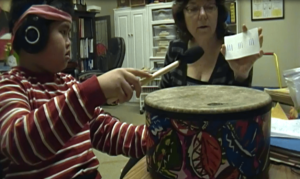Blog
From Silence to Sound-Part 3
Hank’s Emerging Story
Drumming Bridged the Gap to Blend Sounds into Words
“Reading” a simple written notation, Hank imitated fast versus slow beats on a drum after my modeling those rhythmic patterns. That method bridged the cognitive and auditory gap so he could comprehend the idea blending sounds in a sequential order. He was then able to “read” the mouth form cards representing specific sounds he could make, then imitate those sounds in a sequential order that created a specific noun. A picture and the written word representing the noun were introduced while I said the word slowly.
Hank had previously enjoyed playing a phoneme awareness game on the computer that required him to blend syllables and sounds together to represent a word pictured. This had previously been impossible, but he loved playing the game with someone giving him the answers. Now that game started making sense to him and he was able to accomplish the task with only minimum help. He also began trying to imitate the sounds he was hearing in the game.

Following Verbal Computer Directions
Hank also loved playing the computer game, Hear Builder: Following Directions, which required identifying specific objects named and understanding basic language concepts (www.superduperinc.com). This game had been very challenging for Hank, but as he improved in his verbal imitation abilities he also improved in his following direction skills.
This was his favorite game at our last session. He required a written cue when a new concept was introduced to be successful at completing tasks requiring understanding of complex verbal commands. Each command must be visually and kinesthetically introduced before he comprehended the verbal signal. Usually he grasped the new concept in 2-3 trials. His mother used to sadly refer to him as her child with a “little brain.” She started realizing that Hank is quite bright with the right learning channel presented to him.
Separating Sounds to Approximate Words and Communicate Spontaneously
To my surprise Hank returned after a weekend spontaneously using the segmented sounds in a meaningful way to name the pictures we were paired with the question, “What is it?” The auditory to verbal connection had been made and Hank wanted to learn to speak. He comprehended ideas faster after observing someone else performing the requested task even though it was a task he had experienced for numerous trials. On that basis, I quickly introduced him to Gemiini software videos as soon as they came out in Spring 2015. He began producing clearer long ‘a’ sounds when the videos were paired with separated static mouth forms, and pictures of words spoken (www.gemiini.org).
Blending Sounds to Create Clearer Words
Ten years old at this time, Hank’s verbal communication is just beginning to emerge. This is highly unusual for a non-verbal child this old to begin talking. He has just started synthesizing those segmented sounds together on some oft repeated words. His words are distorted and he has a flat robotic voice quality common to autistic children, but he is communicating and answering questions regarding preferences and requests appropriately. I am excited to be a part of Hank’s amazing journey from silence to sound. Addressing his auditory processing deficits has been a large part of this remarkable boy’s journey.
https://www.ctsdallas.com/services/therapies/intensive-therapy-programs/
Hank’s story represents one child’s journey from silence to sound but it also embodies elements of numerous children who have been my teachers over the years. Hank’s story has been used with permission from his parents.
